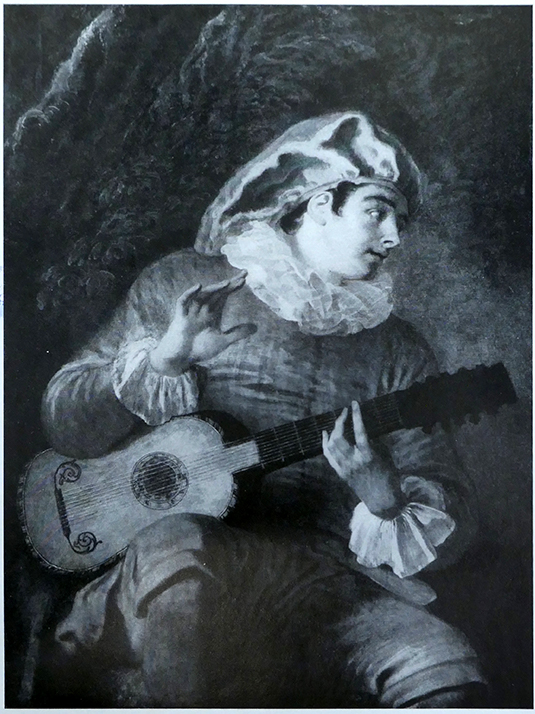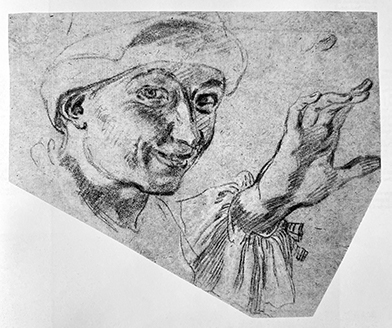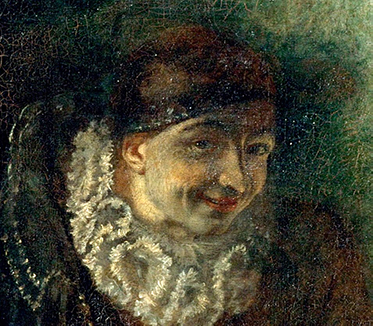
- Home Page
- Accepted
Paintings & Copies - Doubtful
Attributions - Doubtful Textual References
- Alternative
Titles - Collectors &
Museums - Bibliography
- Search Abecedario
- Watteau &
His Circle
Mezzetin à la guitare
Entered September 2020; revised June 2021
Whereabouts unknown
Oil on canvas
110.5 x 84 cm
ALTERNATIVE TITLES
Le Joueur de guitare
Mezzetino mit Gitarre
PROVENANCE
Paris, Adolph-Eugène-Gabriel Roëhn (1780-1867; artist). His sale, Paris, 1868, lot 81: “WATTEAU (ANTOINE) . . . Le Mezzettin. Il est vu jusqu’aux genoux, assis sur un tertre, vêtu d’un justaucorps, d’une culotte courte, une fraise orne son cou, une toque rejetée en arrière. Lui couvre la tête, il pince de la guitare. Vue de face, il tourne la tête à droite, semblant chercher de ce côté l’effet produit par un accord qu’il vient de faire vibrer.
Dans l’exécution de cette Joyeuse figure, l’esprit pétille sous le pinceau original de Watteau. Les étoffes y sont admirablement choisies et ajustées avec un goût parfait. Son attitude est rendue avec une si grande verité, que cette figures semble la nature même, tant elle a de vie et de movement.” Sold for 9,200 francs.Vaduz, Liechtenstein, private collection.
EXHIBITIONS
Munich, Residenz, Europäisches Rokoko (1958), cat. 219 (as Watteau, Mezzetino mit Gitarre, lent by private collection, Vaduz).
SELECT BIBLIOGRAPHY
Adhémar, Watteau (1950), under cat. 206.
Mathey, “Une feuille d’études” (1956), 211ff.
Mathey, Peintures réapparues (1959), 54-55, 80,
Rosenberg and Prat, Watteau, catalogue raisonné des dessins (1996), under cat. 464.
RELATED DRAWINGS
The attribution of the Vaduz painting to Watteau is strengthened by a study in Munich of the guitarist’s upraised right hand and sleeve (Rosenberg and Prat 464). Fortunately, there is no doubt about the authorship of the drawing, especially since the head was used by Watteau for the character of the Doctor in the artist’s chef d’oeuvre, the Gilles in the Louvre.
REMARKS
It is intimidating to ascribe a painting to Watteau that one has not seen firsthand, that was not engraved for the Jullienne Oeuvre gravé, and does not have a history of acceptance by earlier scholars. Yet that is exactly the situation here. The only critic to have written extensively on this picture is Jacques Mathey and that, frankly, works against the painting because Mathey ascribed so many dubious and outrightly bad pictures to Watteau. Nonetheless, the evident high quality of the Vaduz picture and the plaintive, poetic mood of the actor are sufficiently persuasive grounds for accepting the attribution. Moreover, the drawing of the guitarist’s hand in Munich is important evidence in favor of the attribution.
The guitarist looms large on the canvas, overwhelming the small elements of landscape visible at the sides. This sense of monumentality parallels the composition of Watteau’s Gilles, where not only is the scale of the figures exceptionally large but also the presence of the characters is strongly felt. It is significant that the study of the comedian’s head on the Munich drawing was used for one of the comedians in the Gilles. This conjunction suggests that the two paintings were executed around the same time, late in Watteau’s career.
According to Jacues Mathy, who evidently knew the private collector in Vaduz, the painting figured in the collection of the duc de V. However, that collector’s sale on April 7, 1862, lot 3, was a thematically related but different picture: “WATTEAU (ANTOINE) . . . Le Joueur de guitare. – Cette jolie figure, vigoureusement peinte, se détache sur un ciel lumineux et de jolis fonds de paysages ornés de figures.” The Vaduz painting does not contain a background landscape with figures. The duke must have owned one of the other paintings of a guitarist ascribed to Watteau.
Mathey also claimed that the painting was later owned by Charles Francis Mac Dermot and Madame Ruddle Brown, about whom nothing is known. Whether that provenace is correct remains to be verified. It should be noted that Mathey was unaware of the true provenance, namely that the painting had been in the Roëhn collection.
For copies of Mezzetin à la guitare Click Here


